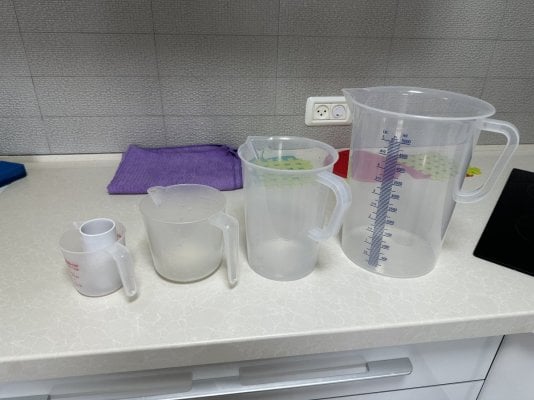Sodium hydroxide raises pH equally to kalkwasser when increasing equal units of alkalinity. Sodium hydroxide is caustic. Please read this for your safety:
Many people enjoy using Sodium hydroxide because you can make it more concentrated than kalkwasser. This tutorial uses the standard DIY 2 and 3 Part concentration.
BE CAREFUL WITH THIS SOLUTION: IT HAS A pH ABOVE 14. Avoid contact with eyes and skin.
If your hands or skin ever feel slippery during this process, wash them immediately. This will happen when sodium hydroxide comes in contact with skin.
Use proper PPE, including gloves, goggles, and a lab coat, to protect yourself from spills.
This method is highly refined, perfected after over two years of mixing and making batches.
Items Needed:
Step 1: Fill the plastic jug about 3/4 full with RO/DI water and refrigerate overnight until cold.
You can also use ice or partially frozen RO/DI. I find partially frozen water still very cold, even after adding the hydroxide, so it’s probably a bit overkill, but there’s no harm in doing so: the cold won’t ruin the sodium hydroxide.
Step 2: Weigh out 283g of sodium hydroxide per gallon in the glass container.
Step 3: Using the funnel, carefully pour the dry sodium hydroxide into the plastic jug.
Step 4: Cap the jug, hold the cap firmly, and shake vigorously to dissolve the sodium hydroxide and disperse the heat. Cold water prevents the jug from becoming too hot to handle or potentially melting, as the exothermic reaction generates significant heat. This step eliminates the need for magnetic stirrers and transferring multiple small batches.
Step 5: If any sodium hydroxide remains in the glass beaker/cup, add some water and gently swirl or stir with a glass rod to dissolve. Pour the dissolved hydroxide into the solution.
Step 6: Top off the jug with RO/DI water and gently invert a few times.
Here are some photos of the process:

283 grams of NaOH in a beaker beside a refrigerated jug of RO/DI water.

This funnel is extremely useful for this project. I like the large size of it for easy and quick decanting.
For questions, concerns, or feedback, feel free to reach out here.
Happy Mixing!
Many people enjoy using Sodium hydroxide because you can make it more concentrated than kalkwasser. This tutorial uses the standard DIY 2 and 3 Part concentration.
BE CAREFUL WITH THIS SOLUTION: IT HAS A pH ABOVE 14. Avoid contact with eyes and skin.
If your hands or skin ever feel slippery during this process, wash them immediately. This will happen when sodium hydroxide comes in contact with skin.
Use proper PPE, including gloves, goggles, and a lab coat, to protect yourself from spills.
This method is highly refined, perfected after over two years of mixing and making batches.
Items Needed:
- Food-grade sodium hydroxide
- Plastic gallon jug (polypropylene or polyethylene, such as HDPE, which is often used for vinegar bottles)
- Funnel
- Glass beaker or cup
- Gram scale
- Refrigerated RO/DI water
- Gloves and other protective gear
- Paper towels and a nearby sink for accidental spills
- Optional: Glass rod
Step 1: Fill the plastic jug about 3/4 full with RO/DI water and refrigerate overnight until cold.
You can also use ice or partially frozen RO/DI. I find partially frozen water still very cold, even after adding the hydroxide, so it’s probably a bit overkill, but there’s no harm in doing so: the cold won’t ruin the sodium hydroxide.
Step 2: Weigh out 283g of sodium hydroxide per gallon in the glass container.
Step 3: Using the funnel, carefully pour the dry sodium hydroxide into the plastic jug.
Step 4: Cap the jug, hold the cap firmly, and shake vigorously to dissolve the sodium hydroxide and disperse the heat. Cold water prevents the jug from becoming too hot to handle or potentially melting, as the exothermic reaction generates significant heat. This step eliminates the need for magnetic stirrers and transferring multiple small batches.
Step 5: If any sodium hydroxide remains in the glass beaker/cup, add some water and gently swirl or stir with a glass rod to dissolve. Pour the dissolved hydroxide into the solution.
Step 6: Top off the jug with RO/DI water and gently invert a few times.
Here are some photos of the process:
283 grams of NaOH in a beaker beside a refrigerated jug of RO/DI water.
This funnel is extremely useful for this project. I like the large size of it for easy and quick decanting.
For questions, concerns, or feedback, feel free to reach out here.
Happy Mixing!
Last edited:
























